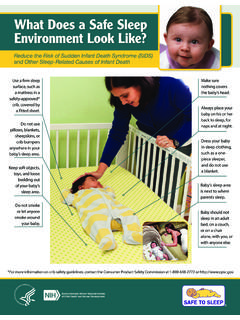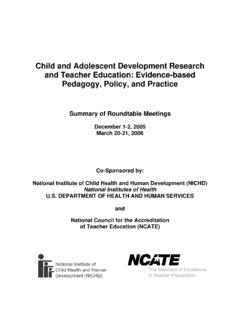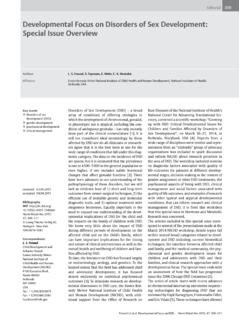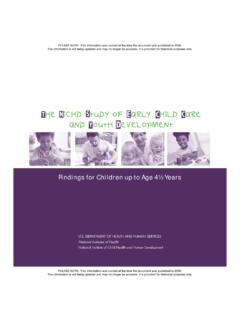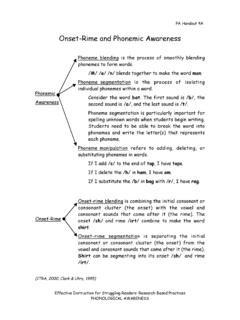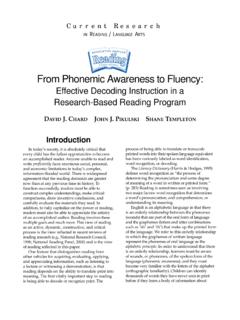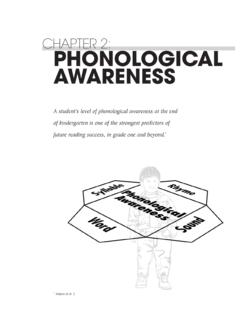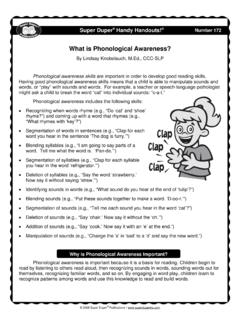Transcription of National Reading Panel - Teaching Children to Read: An ...
1 Acknowledgments The National Reading Panel wishes to express its gratitude to the following individuals for their contributions to its effort. Marilyn Adams Ed Bouchard Harris Cooper Gerald Duffy Michelle Eidlitz Barbara Foorman David Francis Ester Halberstam Blair Johnson Alisa Kenny Helen S. Kim Marjolaine Limbos Khalil Nourani Simone Nunes Elizabeth S. Pang Joan Pagnucco Michael Pressley David Reinking Scott J. Ross Barbara Schuster Robin Sidhu Steven Stahl Maggie Toplak Zoreh Yaghoubzadeh Reports of the Subgroups ii Members of the National Reading Panel Donald N. Langenberg, , Chair Gloria Correro, Linnea Ehri, Gwenette Ferguson, Norma Garza, Michael L. Kamil, Cora Bagley Marrett, Samuels, Timothy Shanahan, Sally E. Shaywitz, Thomas Trabasso, Joanna Williams, Dale Willows, Joanne Yatvin, MEMBERS OF THE National Reading Panel SUBGROUPS. Alphabetics Comprehension Fluency Linnea Ehri, Chair Michael L.
2 Kamil, Chair Samuels, Co-Chair Gloria Correro Gwenette Ferguson Timothy Shanahan, Co-Chair Timothy Shanahan Norma Garza Sally E. Shaywitz Dale Willows Thomas Trabasso Joanne Yatvin Joanna Williams Methodology Teacher Education Technology/Next Steps Timothy Shanahan, Co-Chair Gloria Corerro, Co-Chair Michael L. Kamil, Chair Sally E. Shaywitz, Co-Chair Michael L. Kamil, Co-Chair Donald N. Langenberg Gwenette Ferguson Norma Garza Cora Bagley Marrett STAFF OF THE National Reading Panel . F. William Dommel, Jr., , Executive Director Vinita Chhabra, , Research Scientist Mary E. McCarthy, , Senior Staff Psychologist Judith Rothenberg, Secretary Stephanne Player, Support Staff Jaimee Nusbacher, Meeting Manager Patrick Riccards, Senior Advisor iii National Reading Panel Table of Contents Acknowledgments .. ii Members of the National Reading Panel .. iii Chapter 1: Introduction and Methodology Introduction.
3 1-1. Methodology: Processes Applied to the Selection, Review, and Analysis of Research Relevant to Reading Instruction .. 1-5. Chapter 2: Alphabetics Part I: Phonemic Awareness Instruction Executive Summary .. 2-1. Report .. 2-9. Appendices .. 2-53. Part II: Phonics Instruction Executive Summary .. 2-89. Report .. 2-99. Appendices .. 2-145. Chapter 3: Fluency Executive Summary .. 3-1. Report .. 3-5. Appendices .. 3-35. Chapter 4: Comprehension Executive Summary .. 4-1. Introduction .. 4-11. Part I. Vocabulary Instruction Report .. 4-15. Appendices .. 4-33. Part II: Text Comprehension Instruction Report .. 4-39. Appendices .. 4-69. Part III. Teacher Preparation and Comprehension Strategies Instruction Report .. 4-119. Appendices .. 4-133. v National Reading Panel Chapter 5: Teacher Education and Reading Instruction Executive Summary .. 5-1. Report .. 5-3. Appendices.
4 5-19. Chapter 6: Computer Technology and Reading Instruction Executive 6-1. Report .. 6-3. Appendices .. 6-13. Minority View Reports of the Subgroups vi Introduction REPORTS OF THE SUBGROUPS. Introduction Congressional Charge NRP Approach to Achieving the In 1997, Congress asked the Director of the National Objectives of Its Charge and Initial Institute of Child Health and Human Development Topic Selection (NICHD), in consultation with the Secretary of The charge to the NRP took into account the Education, to convene a National Panel to assess the foundational work of the National Research Council status of research-based knowledge, including the (NRC) Committee on Preventing Reading Difficulties in effectiveness of various approaches to Teaching Children Young Children (Snow, Burns, & Griffin, 1998). The to read. The Panel was charged with providing a report NRC report is a consensus document based on the best that should present the Panel 's conclusions, an judgments of a diverse group of experts in Reading indication of the readiness for application in the research and Reading instruction.
5 The NRC Committee classroom of the results of this research, and, if identified and summarized research literature relevant to appropriate, a strategy for rapidly disseminating this the critical skills, environments, and early developmental information to facilitate effective Reading instruction in interactions that are instrumental in the acquisition of the schools. If found warranted, the Panel should also beginning Reading skills. The NRC Committee did not recommend a plan for additional research regarding early specifically address how critical Reading skills are most Reading development and instruction.. effectively taught and what instructional methods, Establishment of materials, and approaches are most beneficial for students of varying abilities. the National Reading Panel In order to build upon and expand the work of the NRC. In response to this Congressional request, the Director of Committee, the NRP first developed an objective NICHD, in consultation with the Secretary of Education, research review methodology.
6 The Panel then applied constituted and charged a National Reading Panel (the this methodology to undertake comprehensive, formal, NRP or the Panel ). The NRP was composed of 14 evidence-based analyses of the experimental and quasi- individuals, including (as specified by Congress) leading experimental research literature relevant to a set of scientists in Reading research, representatives of colleges selected topics judged to be of central importance in of education, Reading teachers, educational Teaching Children to read. An examination of a variety of administrators, and parents. The original charge to the public databases by Panel staff revealed that NRP asked that a final report be submitted by approximately 100,000 research studies on Reading have November 1998. been published since 1966, with perhaps another 15,000. When the Panel began its work, it quickly became appearing before that time.
7 Obviously, it was not apparent that the Panel could not respond properly to its possible for a Panel of volunteers to examine critically charge within that time constraint. Permission was this entire body of research literature. Selection of sought and received to postpone the report's submission prioritized topics was necessitated by the large amount deadline. A progress report was submitted to the of published Reading research literature relevant to the Congress in February 1999. The information provided in Panel 's charge to determine the effectiveness of Reading the NRP Progress Report, the Report of the National instructional methods and approaches. A screening Reading Panel , and this Report of the National Reading process was, therefore, essential. Panel : Reports of the Subgroups reflects the findings and The Panel 's initial screening task involved selection of determinations of the National Reading Panel .
8 The set of topics to be addressed. Recognizing that this selection would require the use of informed judgment, the Panel chose to begin its work by broadening its 1-1 National Reading Panel Chapter 1: Introduction and Methodology understanding of Reading issues through a thorough The importance of phonemic awareness, phonics, analysis of the findings of the NRC report, Preventing and good literature in Reading instruction, and the Reading Difficulties in Young Children (Snow, Burns, & need to develop a clear understanding of how best Griffin, 1998). Early in its deliberations the Panel made to integrate different Reading approaches to a tentative decision to establish subgroups of its enhance the effectiveness of instruction for all members and to assign to each subgroup one of the students;. major topic areas designated by the NRC Committee as The need for clear, objective, and scientifically central to learning to read Alphabetics, Fluency, and based information on the effectiveness of different Comprehension.
9 Types of Reading instruction and the need to have Regional Public Hearings such research inform policy and practice;. The importance of applying the highest standards of As part of its information gathering, the Panel publicly scientific evidence to the research review process so announced, planned, and held regional hearings in that conclusions and determinations are based on Chicago, IL (May 29,1998), Portland, OR (June 5, findings obtained from experimental studies 1998), Houston, TX (June 8, 1998), New York, NY characterized by methodological rigor with (June 23, 1998), and Jackson, MS (July 9, 1998). The demonstrated reliability, validity, replicability, and Panel believed that it would not have been possible to applicability;. accomplish the mandate of Congress without first hearing directly from consumers of this information The importance of the role of teachers, their teachers, parents, students, and policymakers about professional development, and their interactions and their needs and their understanding of the research.
10 Collaborations with researchers, which should be Although the regional hearings were not intended as a recognized and encouraged; and substitute for scientific research, the hearings gave the The importance of widely disseminating the Panel an opportunity to listen to the voices of those who information that is developed by the Panel . will need to consider implementation of the Panel 's findings and determinations. The regional hearings gave Adoption of Topics To Be Studied members a clearer understanding of the issues important Following the regional hearings, the Panel considered, to the public. discussed, and debated several dozen possible topic As a result of these hearings, the Panel received oral and areas and then settled on the following topics for written testimony from approximately 125 individuals or intensive study: organizations representing citizens teachers, parents, Alphabetics students, university faculty, educational policy experts, and scientists who would be the ultimate users and - Phonemic Awareness Instruction beneficiaries of the research-derived findings and - Phonics Instruction determinations of the Panel .
